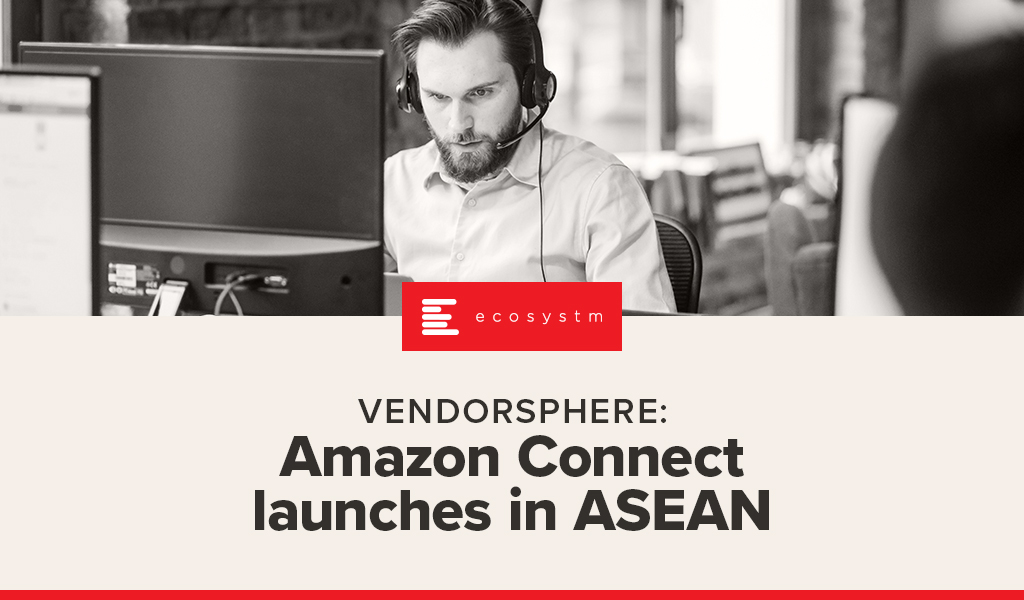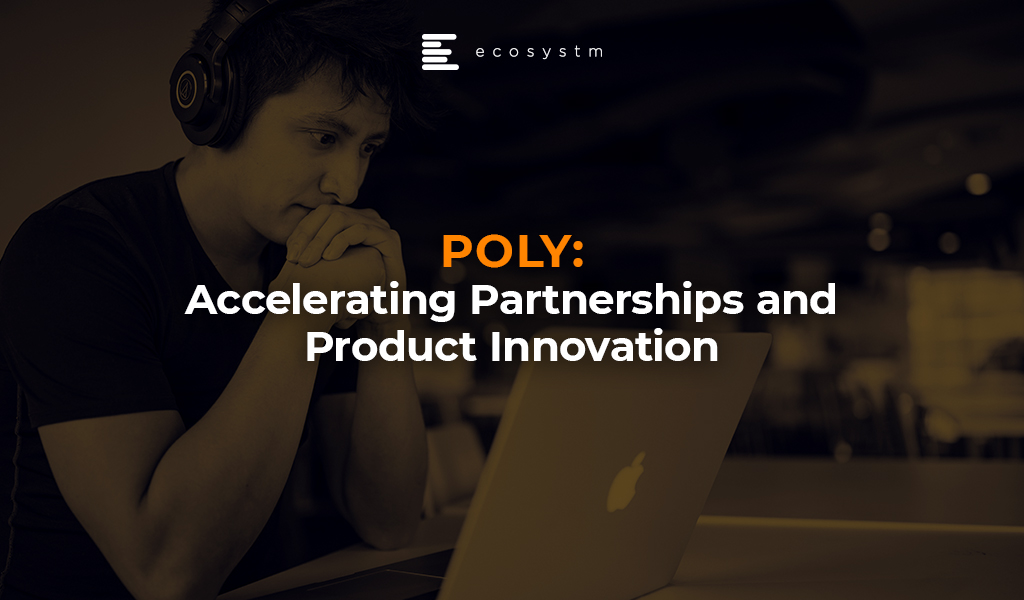This week, Vodafone New Zealand launched a contact centre solution known as Vodafone Connect that runs on AWS cloud infrastructure. The solution is designed for contact centres and customer service providers to reduce their operating cost and deliver an improved customer experience (CX).
The move comes as many businesses and governments are witnessing a spike in inbound contact centre volumes since the outbreak of the pandemic. The telecom company aims to help the contact centre industry through its on-demand contact centre suite of solutions that can be scaled up or down according to the organisations’ requirements. It can be combined with existing CRM platforms in a single dashboard for better access to data and resolution support.
Vodafone Connect is built on the AWS Connect cloud contact centre solution and uses data analytics and machine learning tools to automate customer interactions across multiple channels – email, messaging and social media – to support the contact centre agents with real-time information.
COVID-19 has accelerated the move to the cloud
The recent pandemic has seen many organisations make a leap almost overnight to cloud contact centre technologies. Many organisations that previously had concerns around data privacy, and securing customer data – and were thus hesitant about deploying cloud contact centre solutions – have moved to the cloud model. The cloud model helped get agents that were forced to work from home up and running in a short duration. The immediate urgency was primarily due to a massive spike in voice calls and non-voice activity such as emails. During the COVID-19 crisis, many organisations used Virtual Private Network (VPN) connections to their legacy on-premises phone system to enable the remote agents. However, there have been challenges reported by many organisations with that approach such as increases to IT budget, difficulty in scaling easily, and the requirement for more IT support that could have been avoided.
Ecosystm research finds that only 30% of organisations have fully migrated their cloud contact centre solutions on the cloud. 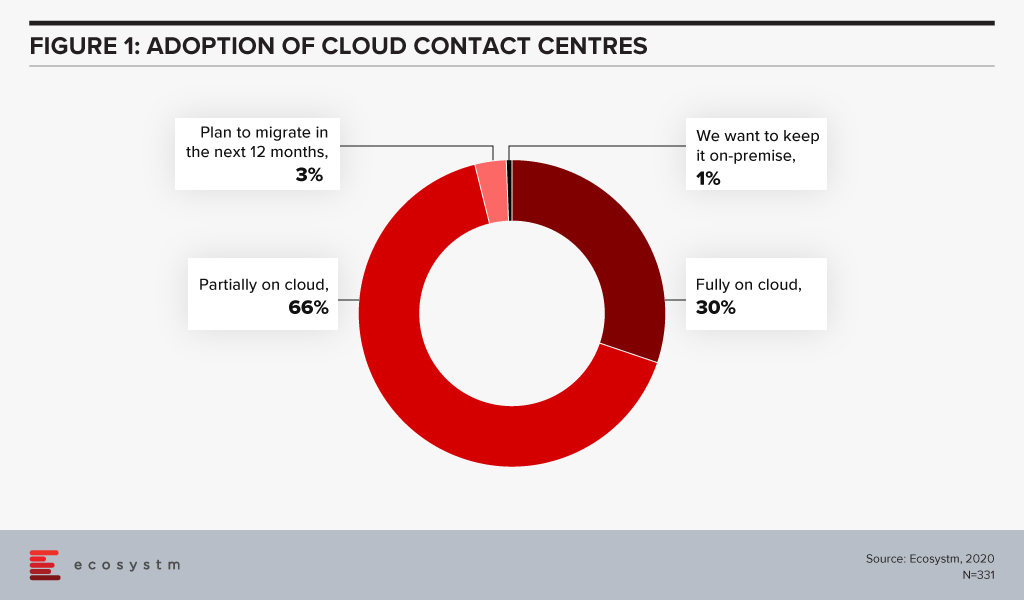
This indicates a market opportunity for vendors in the cloud contact centre space. The COVID-19 pandemic has definitely triggered a strong move towards the cloud model. It has become imperative for vendors and solutions providers to strengthen their cloud capabilities.
Driving an Omni-Channel Experience has become increasingly difficult
Ecosystm research also finds that organisations find siloed organisational data as one of the biggest challenges in driving consistent customer experience.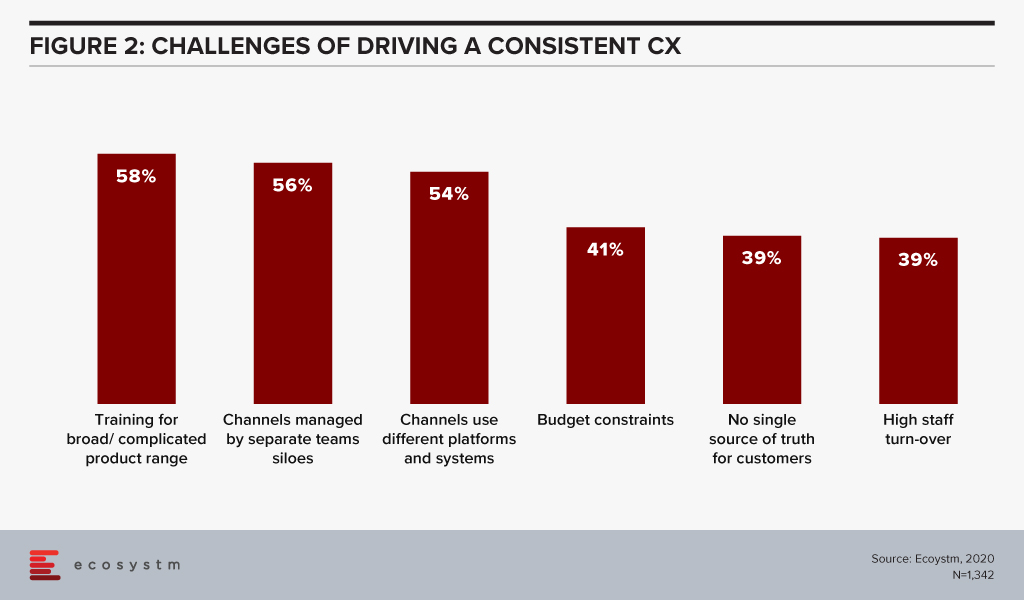
This has been further exacerbated by the high volume of interactions that organisations have been having with their customers, and the need to accommodate work-from-home policies for their customer care agents. At the same time, nearly 60% of organisations want to drive an omni-channel experience to improve CX. This provides a huge opportunity for contact centre vendors and partners to offer consulting services to help organisations bridge the gaps in achieving an omni-channel experience. For many organisations there has been a greater push to integrate CRM, the voice of the customer/surveys, customer journey analytics to the contact centre technologies and this is not an easy task as it involves different stakeholders with different sets of KPIs. Having a single platform that can manage this omni-channel experience will be a huge benefit for many organisations.
New Players in the Competitive Landscape
AWS is a relatively new player in the contact centre market, but it is starting to disrupt the existing players, with a global installed base. However, it is worth noting that Avaya, Cisco and Genesys have a higher installed base and they continue to win new deals. The move to the cloud is witnessing more service providers, telecom providers and other contact centre partners push more cloud-based solutions in the market. Apart from AWS, other important players include NICEinContact, 8×8, Talkdesk, Twillio, Five9, and UJet. The competitive battleground is heating up and there are a lot of options for customers to choose from. It will all come down to working with a vendor that can help them achieve their desired CX outcomes.
There are other important elements in CX that are growing in importance and these include conversational AI, voice biometrics, knowledge management systems, machine learning and CX management solutions. Contact centre solution providers are having discussions around these areas with tech buyers. This will mean that we can expect deeper partnerships and acquisitions in the short to medium term. Security has also emerged as an important issue to be resolved, especially with agents working from home. This is from a compliance perspective and pertaining to how agents are viewing and handling customer data. These new trends indicate that customers will need to work with different vendors to solve the variety of issues they are facing.
The Vodafone Connect solution on AWS Connect is one of the many examples of how more partners of contact centre solutions are gearing up for the rapid move to the cloud. Globally, Vodafone also sells contact centre solutions from Cisco and Genesys. The next 3 years will see a great movement in the market and this will include vendors from North America that will set up operations to push their offerings across Europe and the Asia Pacific.
Click below to access insights from the Ecosystm Contact Centre Study on visibility into organisations’ priorities when running a Contact Centre (both in-house and outsourced models) and the technologies implemented and being evaluated
Contact centres across industries are being challenged by the current crisis because of the high volume of inbound interactions – through voice and non-voice channels. This has been further compounded by the need to move most of their customer care agents to their homes, especially in countries that have implemented strict social distancing and lockdown measures. This is particularly challenging for the public sector because they are having to respond to an influx of citizen queries regarding COVID-19 specifically (including test centres and availability) and other related areas (information on trade and travel, economic stimulus and so on).
Public Sector Focus on Citizen Experience
Ecosystm research reveals that public sector organisations are hugely focused on citizen experience (Figure 1). But other priorities include employee experience and innovation in their service provision.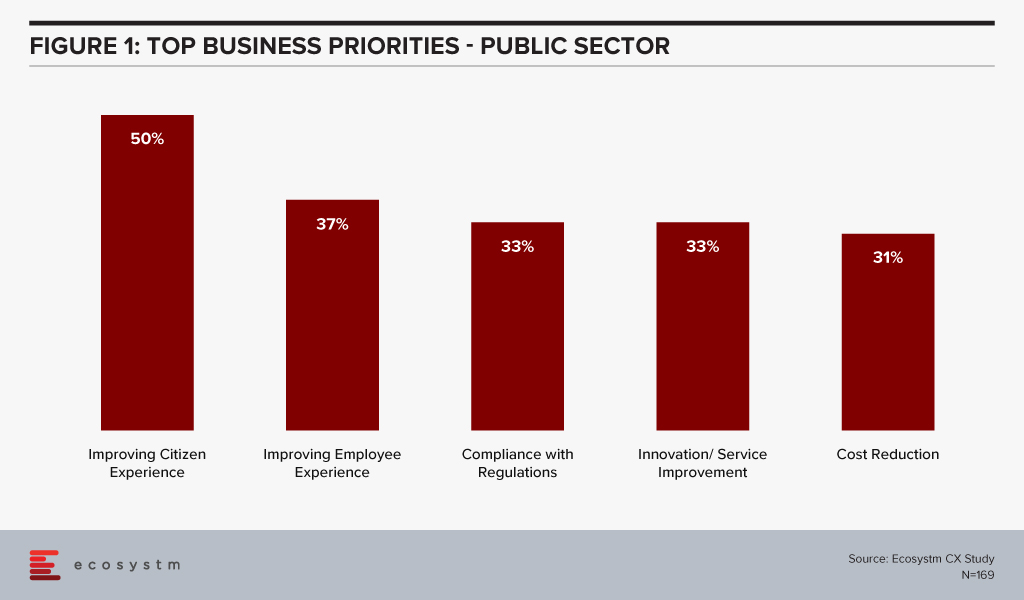
Being able to provide better and innovative service to citizens in a compliant manner is key for every public sector organisation. This has led to governments driving the uptake of cloud solutions, such as the New Zealand Government’s directive to public sector organisations that public cloud services are preferred over traditional IT systems, in order to enhance citizen experiences, streamline operations and create new delivery models. In 2018, the Singapore Government had announced the intention to use commercial cloud services in the public sector. This was fueled as much by the need to overhaul ageing infrastructure, as it was to provide exceptional citizen experience.
Public Sector Adopting Cloud Contact Centres
While the private sector is often quicker in their adoption of digital technologies for better customer experience (CX), the adoption in the public sector can be challenging due to various concerns such as legacy systems, privacy, national security, inter-departmental dependency and more. Ecosystm Principal Advisor, Audrey William says, “Most cloud contact centre solution providers today have the highest level of security wraps and certifications including country-level certifications. However, verticals such as Government, have remained concerned about security. This has not allowed them to innovate as fast as some of the other sectors on leveraging some of the best-in-class customer experience technologies.”
In the US, MAXIMUS, a government services provider company and Genesys recently announced a partnership to set up the MAXIMUS Genesys Engagement Platform, an integrated, cloud-based omnichannel contact centre solution. This was driven by the government requirement for public sector organisations to provide seamless customer experiences similar to those offered in the private sector. The platform is certified by the Federal Risk and Authorization Management Program (FedRAMP). FedRAMP promotes the adoption of secure cloud services across the US Federal Government, in partnership with federal agencies, cloud service providers and 3rd party assessment organisations and provides the standards for security and risk assessment.
This is in line with what we see in the Ecosystm data. Government agencies that use contact centres are increasingly evaluating cloud options, with 17% saying that they operate fully on the cloud (Figure 2). While this may be difficult for all public sector organisations, with mandates around data location and security, a majority are partially on the cloud.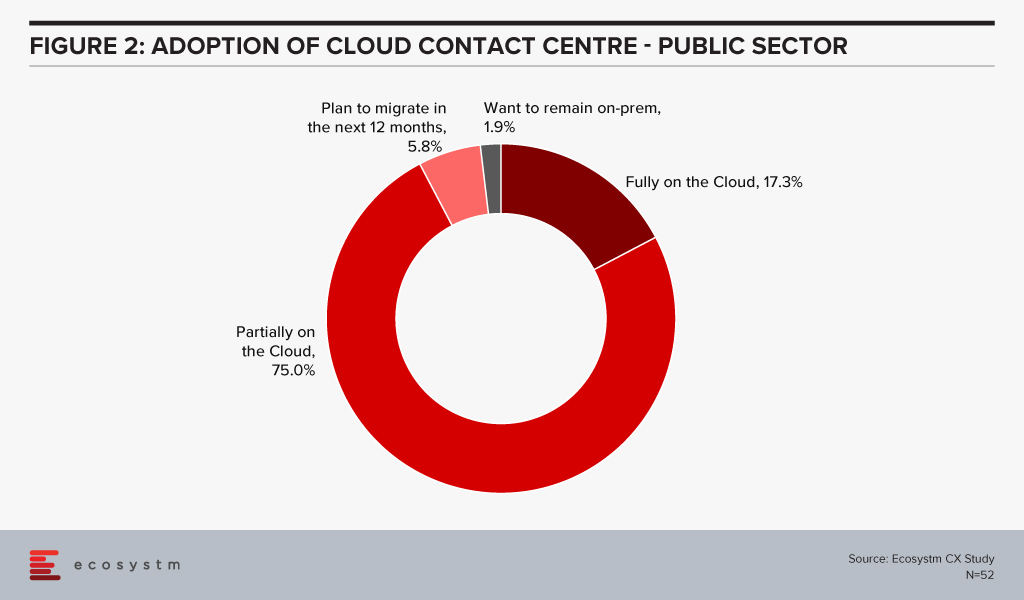
There are several benefits to using the cloud model including the ability to make changes and scale up/down without much customisation or professional services (which can come in handy for a quick re-alignment of the workforce) and manage seasonal spikes. Additionally, cloud solutions allow almost instantaneous access to new features and easy testing of proofs of concept. Public sector organisations are fast realising the value of cloud contact centres.
William sees the FedRAMP certification having immense potential. “FedRamp provides a secured environment for any service that is rolled out as this involves multiple levels of security. Citizens expect a more personalised service through chat, Twitter, mobile, social messaging channels like WhatsApp and many more. However, they also want to feel safe when providing personal information and want to know that the platform that holds their data is secure. When they know that security is at the highest level, they will be more open to providing personal data.”
Managing an Omnichannel Experience
Over half of public sector organisations in the Ecosystm CX study mentioned that they are driving an omnichannel experience for their customers. This has become especially relevant today, as organisations have the need to reduce the call volumes for their contact centres – through non-voice services and customer self-service. The MAXIMUS Genesys Engagement Platform will leverage Genesys Engage, which provides integrated features and functionalities across multiple channels through a single voice and digital user interface. Solutions such as these provide the ability to integrate calls, emails, chats, messages and social comments into one connected platform.
William says, “The cloud platform can help with the highest level of efficiency, scale and speed by integrating multiple channels on a single platform, for more connected customer experience. Government departments will look to leverage capabilities such as Conversational AI, in-app mobile messaging, SMS, email and voice calls within a multi secure environment. Citizens have high expectations from government departments – they expect fast, reliable and efficient service and automation. It would be difficult for governments to provide that level of service without leveraging cloud contact centre technology. That is the only way to move away from inefficient traditional architectures.”
Speaking about the adoption of cloud contact centres in the Asia Pacific region, William says, “Despite initiatives like Australia’s Digital Transformation Agency, the adoption has been relatively low in the public sector. But that has been changing fast with the COVID-19 situation forcing some government departments to move almost immediately to the cloud allowing easier changes to call workflows and other dynamic services that may have to be addressed on a daily basis.”

In 2018, DBS Bank came together with AI start-up impress.ai to implement Jim – Job Intelligence Maestro – a chatbot that helps the bank shortlist candidates for positions in their wealth planning team. This is primarily for screening for entry-level positions. Apart from process efficiency, the introduction of AI in the recruitment process is also aimed at eliminating bias and objectively finding the right candidate for the right job. The DBS chatbot uses cognitive and personality tests to assess candidates, as well as providing them with answers to the candidates’ frequently asked questions. The scores are then passed on to actual recruiters who continue with the rest of the recruitment process. DBS claims that they have curtailed the initial assessment time of each applicant by an average of 22 minutes.
While some organisations have started evaluating the use of AI in their HR function, it has not reached a mass-market yet. In the global Ecosystm AI study, we find that nearly 88% of global organisations do not involve HR in their AI projects. However, the use cases of AI in HR are many and the function should be an active stakeholder in AI investments in customer-focused industries.
Telstra employs AI to vet Applicants
Last month, Australia’s biggest telecommunications provider Telstra announced its plans to hire 1,000 temporary contact centre staff in Australia to meet the surge in demand amidst the global pandemic. In response to the openings, Telstra received overwhelming 19,000 applications to go through and filter, with limited workforce. To make the recruitment process more efficient, the company has been using AI to filter the applications – and has been able to make initial offers two weeks from the screening. The AI software takes the candidates’ inputs and processes them to find the right match for the required skills. The candidates are also presented with cognitive games to measure their assessment scores.
Ecosystm Principal Advisor, Audrey William speaks about the pressure on companies such as Telstra to hire faster for their contact centres. “Several organisations are needing to replace agents in their offshore locations and hire agents onshore. Since this is crucial to the customer experience they deliver, speed is of essence.” However, William warns that the job does not stop with recruiting the right number of agents. “HR teams will need to follow through with a number of processes including setting up home-based employees, training them adequately for the high volume of voice and non-voice interactions and compliance and so on.”
The Future of AI in HR
William sees more companies adopting AI in their HR practices in the Workplace of the Future – and the role of AI will not be restricted to recruitment alone. “A satisfied employee will go the extra mile to deliver better customer experience and it is important to keep evaluating how satisfied your employees are. AI-driven sentiment analysis will replace employee surveys which can be subjective in nature. This will include assessing the spoken words and the emotions of an individual which cannot be captured in a survey.”
In the future, William sees an intelligent conversational AI platform as an HR feedback and engagement platform for staff to engage on what they would like to see, what they are unhappy about, their workplace issues, what they consider their successes and so on. This will be actionable intelligence for HR teams. “But for a conversational AI platform to work well and to encourage users within the organisation to use it, it must be designed well. While it has to be engaging to ensure employee uptake, the design does not stop at user experience. It must include a careful evaluation of the various data sets that should be assessed and how the AI can get easy access to that data.”
AI and Ethics
With the increased use of AI, the elephant in the room is always ethical considerations. While the future may see HR practices using conversational AI platforms, how ethical is it to evaluate your employees constantly and what will be the impact on them? How will the organisation use that data? Will it end up giving employers the right reasons to reduce manpower at will? These and allied issues are areas where stricter government mandates are required.
Going back to AI-assisted recruitment, William warns, “Bias must be assessed from all angles – race, education, gender, voice, accents. Whilst many platforms claim that their solution removes bias, the most important part of getting this right is to make sure that the input data is right from the start. The outcomes desired from the process must be tested – and tested in many different ways – before the organisation can start using AI to eliminate bias. There is also the added angle of the ethical use of the data.”
Agents are the most valuable assets in a contact centre. In the current environment, the biggest threat is agents getting infected, causing the closure of contact centres for weeks or possibly even longer. We are already seeing the impact of that with offices being shut, students not going to school and industry gatherings and events being put on hold or cancelled. So having a business continuity plan (BCP) is critical. The BCP should include ways to continue to engage with customers.
The contact centre manages live interactions. Every second there are voice calls coming in, emails received and self-service tools being accessed. It is important to have multiple backup plans – both from a people and a technology perspective – to keep operations running effectively, without calls being put on hold too long or with other channels going unanswered. Contact centres battle with these challenges every day and the situation will get far more serious with the ongoing changes we are witnessing.
Some important considerations include:
Having a backup plan allowing agents working from home
More contact centres today are gearing up to agents working from home, but the process is not an easy one. To begin with, the initial set up includes having the right connectivity and a reliable network. Ensuring that the agent has the right working environment with minimal distraction is crucial. A good quality headset can help. A poor-quality headset will only create unwanted problems with understanding customer issues and handling them. Other concerns include security, tracking how data is being handled, agent under-performance and safety of the agents from an operational and health perspective. Measures such as listening to call recordings and storing them centrally are growing in importance. Multi-factor authentication and analytics using agent logs are some measures that can be put in place.
While there are lots of tools and technologies to monitor and check on agents, the key for home-based agents will be trust. Some outsourced contact centre providers that have been using home-based agents for years have stated that having trust and not micromanaging the agents, is essential for the model to work. Some contact centres have also deployed a BYOD policy for home-based agents assuming the right security, device management, application management and authentication measures are in place.
Organisations should also consider actively recruiting additional home-based agents. These agents could be retirees, currently unemployed or people with mobility issues who prefer to work from home.
Given the difference in the working environment, the metrics used to measure agent performance needs to be modified to be more realistic and fair to both agents and organisations.
Employing home-based agents will drive employment amidst challenges in the economy. Ecosystm research finds that more than a third of organisations do not have provisions for agents working remotely (Figure 1).
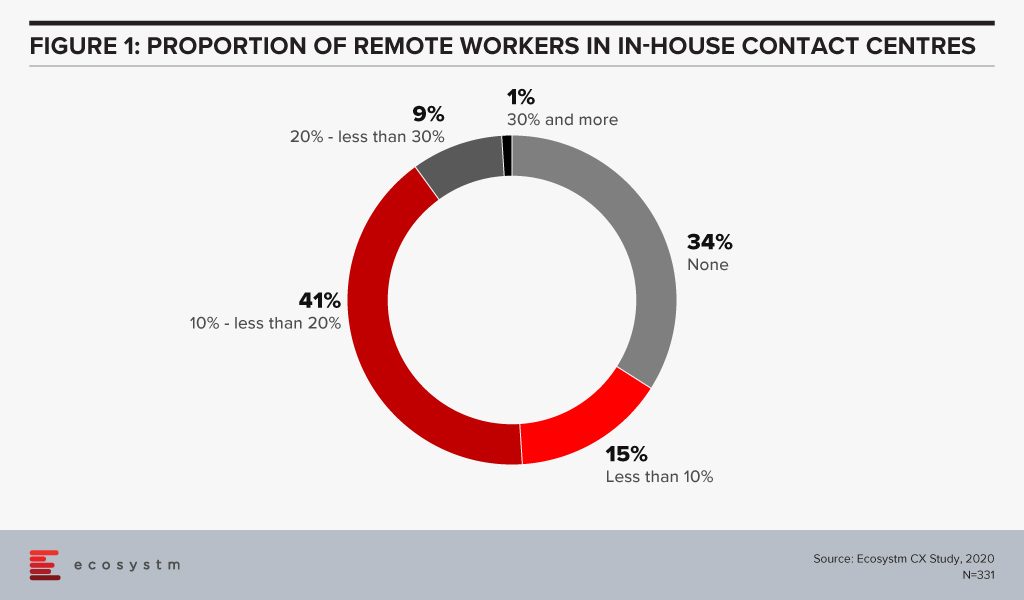
For a long time, the industry has talked about the rise of home-based agents and while it has received positive momentum, it has never really taken off in a big way. This time it will.
Managing spikes in voice and non-voice calls
In industries such as healthcare and airlines, call volumes are exceeding normal volumes. Having the ability to deflect the calls to other non-voice channels will be important. It might need the Interactive Voice Response (IVR) scripts to be changed from time to time to manage the flow of the calls. This is when cloud architecture becomes important. The cloud model can be used to make changes to call workflows easily. The sudden peaks will also require changing the channels easily and without intervention from IT. This is where the agility of cloud comes in as it allows changes and additions – for example when 500 agents need to be added or moved to work on other areas – to be made more easily. Ecosystm research finds that currently, only a third of organisations have their contact centre solutions fully on a cloud, with another 66% with partial cloud solutions. This is set to change with the rise in the number of home-based agents.
There should be thought and planning on how to deflect voice calls to other self-service channels. In the current environment, some organisations deploy a call back option when there is an overflow calls. Similarly looking at deflecting voice calls to self-service channels to ease the load on agents should be evaluated.
Managing back up locations (onshore and offshore)
Contact centre operators are looking at ways to isolate agents and keep them safe. Apart from very strict hygiene measures, organisations are also restricting agents to their specific floor. Some are looking at having agents split into different centres, to contain the risk of mass infection.
Several contact centre operators are building contingency plans to route calls to outside the onshore location in case the situation in a site or a cluster worsens.
For back-end contact centre activities and non-voice calls, taking the load off from the current onshore setup and pushing them offshore, can be an option. The best place to start would be by evaluating each client contract and SLAs especially on security, regulation and privacy issues regarding customer data-handling.
There will be a lot to be considered too should the country go into the full lock-down mode as we are starting to see with a few countries. This makes the case for employing home-based agents stronger.
Using messaging apps, the website and FAQs for daily notifications
Many contact centres are informing citizens and customers about the changes in business operations, services offered, refunds, where to go for help, what do to in an emergency and other essential information through the website, app or the updated FAQ. This will help reduce unnecessary voice and non-voice enquiries to the contact centre. During an emergency, it is normal that phone queries will rise and developing a detailed FAQ is critical to counter that. The more detailed the FAQ giving essential information, the more agents will be able to focus on the more essential day to day activities. Several companies are now sending pop-ups within apps about daily changes to avoid an overflow of inbound enquiries.
Virtual Assistants and Conversational AI can help to ease the load
The more intelligent the virtual assistant and conversational AI platform, the more a customer will be able to get the right response. The challenge has been that many platforms are poorly designed and customers get frustrated because they are unable to get the basic information they need. In times of high inbound activity, if answers to simpler queries can be provided through a chatbot, it can help ease the load on agents. It is good to start planning for this as it will take some time to get the virtual assistant platform up and running and even longer for the algorithms to learn from historical patterns to work well. While it may not be the perfect solution now, planning for a Conversational AI can bring some sort of balance back to the contact centre. Having a solid knowledge management system at the back-end cannot be compromised. Without a good knowledge management system, the virtual assistant solution will force customers to leave the self-service platform and place a call to the contact centre, defeating its very purpose.
The challenging situation we are in is undoubtedly putting pressure on contact centres. It is not uncommon now for customers to be put on hold – for more than two hours and in some extreme cases more than 7 hours! In times like this, understanding data and the patterns around data from each customer touchpoint will help plan the next steps on how best to navigate the situation. Testing and pre-testing the channels and the changes made before they go live must be done rigorously.
Whilst these are very challenging times for the economy, the good news is that contact centres are successfully piloting or have already implemented some or all of the above discussed here. Outsourced contact centre providers are running pilots across various locations and applying technology to deal with the challenges they are witnessing daily. Technology has also come a long way in the contact centre space, and by the application of the right technologies, scale, and business continuity measures, resilience can be achieved.
This blog was created with input from CX leaders across the entire Asia Pacific region. The author wishes to thank everyone for their valuable input.

On December 18, AWS launched Amazon Connect in ASEAN from the Singapore region. I was invited to the ASEAN launch of Connect in Singapore 3 weeks ago where Pasquale DeMaio, GM of Amazon Connect and Robert Killory, ASEAN Solutions Lead presented to analysts.
Pasquale told the audience that the Amazon Connect solution used today has been built over 10 years ago to serve Amazon’s internal needs of servicing millions of customer interactions for their e-commerce transactions. At that time Amazon could not find a solution that was pure cloud-based, cost-effective, scalable and that was easy to use. Since launching Amazon Connect a few years ago, AWS has seen not just small and medium enterprises using Connect – larger organisations have embraced the solution as well.
Amazon Connect has a list of notable clients – Intuit, Rackspace, John Hancock, CapitalOne, GE Appliances, Subway and many others. Intuit, as an example, has had difficulties running experiments in the past and proofs of concept were expensive, complex and time-consuming. With Amazon Connect these run on a test environment allowing their engineers to experiment and if they do not work out, it does not cost Intuit a lot of money to spin up a proof of concept. Philippines telecommunications provider, Globe Telecom wanted to automate and improve their services for their broadband and residential services. It was taking about 2-3 days from payment to the restoration of services. Amazon Connect was deployed to solve this problem by understanding the customer data when calls came through to the contact centre and by using APIs and the Connect suite of applications, there was deep integration with the CRM systems and other platforms that held various pools of data. This produced a faster and scalable way of integrating the payment process and customer service.
The demo of the solution showcased how features such as Amazon Lex can build conversational interfaces for an organisation’s applications powered by the same deep learning technologies like Alexa. With Amazon Lex and Polly, organisations can now build a chatbot without knowing or understanding code.
The Amazon Connect Solution – scaling to become more feature-rich
At ReInvent in Las Vegas in December 2019, Andy Jassy the CEO of AWS unveiled a new offering for their contact centre customers called Contact Lens. The solution is a set of machine learning capabilities integrated into Amazon Connect. The service can be activated through a single click in Connect and can analyse, transcribe calls including previously recorded calls. Jassy also talked about how it allows users to determine the sentiment of the call, pick up on long periods of silence, and times when an agent and customer are talking over the top of each other. These additions can help supervisors understand the challenges faced by agents that can then be addressed during training and coaching sessions. The machine learning models that power Contact Lens for Amazon Connect have been trained specifically to understand the nuances of contact centre conversations including multiple languages and custom vocabularies.
Several other announcements have also been made recently:
- Web and Mobile Chat for customers is a single unified contact centre service for voice and chat. Agents have a single user interface for both voice and chat, reducing the number of screens they have to interact with.
- Amazon Transcribe now supports 31 languages including Indonesian, Malay, Japanese, Korean, and several Indian languages. These are important languages as they expand further across ASEAN and the rest of Asia, given the diversity of languages spoken in the region. Contact centres can convert call recordings into text and analyse the data for actionable intelligence.
Deepening their relationship with Salesforce
At Dreamforce 2019 late last year, Salesforce announced that they will be offering AWS telephony and call transcription services with Amazon Connect as part of their Service Cloud call centre solution. The announcement indicates how the CRM world and the contact centre segments are starting to get closer. CRM vendors are starting to realise that whilst they own the agent at the desktop who have access to the CRM solution, the data from the calls and the actual calls are important. Voice/Telephony is also witnessing greater innovation with vendors in the contact centre space applying machine learning and AI to voice so that intelligence is gathered prior to the call coming to the contact centre and the agent is further empowered through prompts that they can apply when speaking to a customer. As CRM integrates deeper with contact centre solutions, the tight integration between these two solutions cannot be ignored. Salesforce is partnering to innovate in the voice space by applying machine learning at the core of all they do. This is a big announcement given the sheer size of both companies and how both companies are innovating in the contact centre space.
Cloud Contact Centre is high on the agenda in Asia Pacific
Ecosystm’s CX research finds that most organisations in Asia Pacific are at the inflection point of moving from an on-premise environment to a cloud model. Only 1% of CX decision-makers want to keep their contact centres on-premise – many organisations are evaluating which contact centre vendor they should use to migrate to the cloud. Some countries may see higher adoption than others. Australia and New Zealand have higher cloud contact centre adoption. In ASEAN many organisations are starting to build a wider CX strategy beyond the contact centre including areas such as customer journey analytics and data-driven personalised CX.
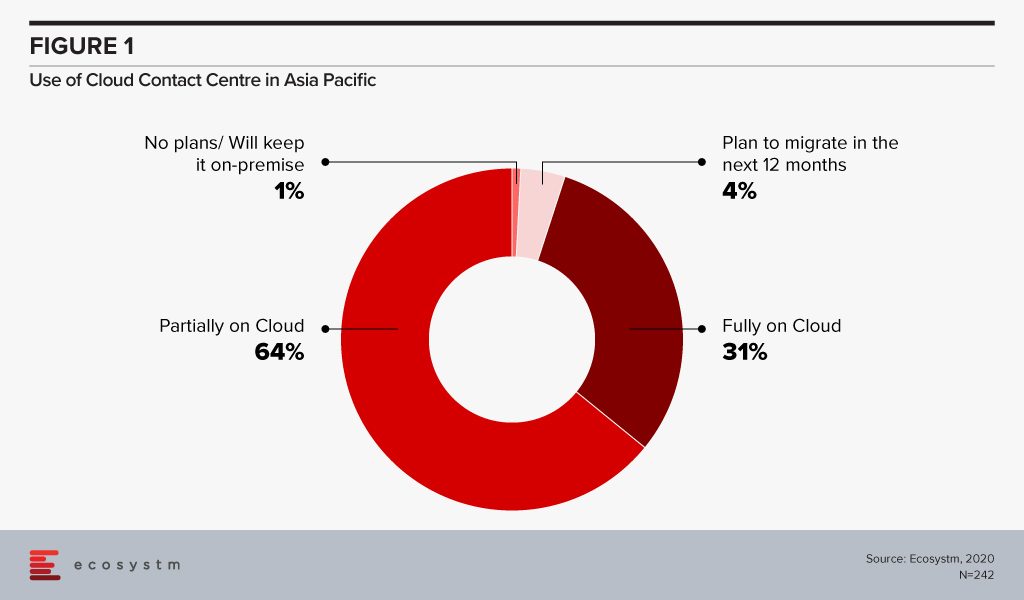
Ecosystm comments
In Australia, Amazon Connect has grown its customer base and these include some large enterprises. Big wins in the last 2 years include National Australia Bank and NSW Health. NSW Health shifted its IT service desk and shared services contact centres onto a new cloud-based contact centre platform as part of a broader digital transformation.
AWS has been gearing up for the launch in ASEAN over the last 6 months. The region is very competitive with some long-standing contact centre players having a large share and installed base in the large and medium enterprise accounts. The launch indicates how serious they are about growing their contact centre business in the region. There has been good progress so far in Singapore and the Philippines. Amazon Connect will look to grow its presence in Indonesia, Malaysia, Thailand, and Vietnam in the months to come. The market dynamics in each Asian country is unique and AWS will work with partners such as Accenture, Deloitte, DXC, ECS, NTT and VoiceFoundry to grow their presence in the region. Some of the more traditional partners will need education and upskilling to understand the Amazon Connect value proposition

Poly’s CEO Joe Burton was in Sydney recently to meet with staff, customers and partners. I had the privilege of interviewing him about the roadmap ahead for the company. Plantronics acquired Polycom for $2 billion at the end of March 2018 and earlier this year at Enterprise Connect, Poly was unveiled as the new brand – the coming together of Plantronics and Polycom. The company prides themselves on the strong engineering heritage they have across their product portfolio. Poly is playing in a large addressable market and these segments include unified communications (UC), video, headsets and contact centres.
Big news last week – Poly and Zoom partnership
At Zoomtopia last week, Zoom announced purpose-built appliances for their Zoom Rooms conference room system. These appliances are custom developed hardware that lets users gather room intelligence and analytics and will simplify installation and management of large-scale conference room deployments. One of the major partnerships for this was with Poly. Joe Burton was on stage with Eric Yuan the CEO of Zoom to unveil the Poly Studio X Series – The X30 (for smaller rooms) and the X50 (for midsize conference rooms).
What is promising about this offering is that the whole concept of launching a meeting by connecting to a screen has become simple. In a world where user experience is everything, simplicity and quality are what end-users expect. The Poly Studio X Series are all-in-one video bars that will simplify the Zoom Rooms experience and will feature Poly Meeting AI capabilities. Some of the features include advanced noise suppression to make it easier to hear human voices while simultaneously blocking out background noise.
For Poly, this is a great partnership given Zoom’s good growth in the Asia Pacific region. Poly is also increasingly deepening their relationships with other major players in the Video and UC market including Microsoft.
Flexible Workspaces and Contact Centres drives the headset market in Asia Pacific
According to JLL, the flexible space sector in Asia Pacific is expanding rapidly. From 2014 to 2017, flexible space stock across the region recorded a CAGR of 35.7% in Asia Pacific – much higher than in the United States (25.7%) and Europe (21.6%) over the same period. When you consider the changes in the modern workplace which include the rise of open flexible workplaces, remote and home working and the rise of freelancers, providing a seamless experience for the office worker will be important – it should be the same for a contractor as it is for full-time staff. As we move into more mobile and agile work practices and with the rise of open offices, headsets will play an important role for the office worker. More organisations across Asia are investing in headsets and whilst it may sound simple to just buy the headsets, it is more sophisticated than that. There is no one-size-fits-all headset and IT managers will have to invest in headsets to suit the persona of employees taking into account the role, workload, use of voice and video services and ultimately their comfort level. Vendors in the headset space are heavily investing in easy-to-use features, more automation, deep workflow integration and machine learning to deliver that experience. The opportunity for headsets does not stop there. In the contact centre space as agents spend long hours on calls, designing the right headset with feature rich AI capabilities will go a long way especially for training and coaching.
The one area Burton emphasised on is how AI and analytics is transforming this market and Poly investing in building these features into the headsets. Some of these examples include:
- Tracking conversations by using analytics to gain insights into long pauses of silence and “overtalking”. The analytics generated from these insights can help for training and coaching.
- AI can help track user behaviour patterns related to noise, volume and mute functions. These patterns can be used to detect problems during the call and could lead to possible training sessions for the agents. It is a great mechanism for supervisors to understand and work through where agents are struggling during the call.
Partnerships to expand their reach into the contact centre markets in the Asia Pacific region will be important. The market for contact centres is seeing a big shift and new entrants are making their presence felt in the Asia Pacific region. Poly will need to capitalise on this and expand their partnerships beyond the traditional vendors to expand their footprints across the contact centre markets.
Asia Pacific – an important growth theatre
Poly continues to win and have some large-scale deployments in Japan, China, India, and ANZ. They have also made several strides to develop what is best fit for the local market in terms of user requirements. With a deep understanding of the Chinese market, Poly released the Poly G200 in September this year which is tailor-made for the Chinese users with easy to use and collaborate solutions. The Poly G200 is the first and significant customised product launched in China, after Poly announced their ‘In China, for China’ strategy. This is a logical move given China is an important market and one that presents its own unique business dynamics.
Conclusion
The shift to mobility and the cloud has changed everything and is driving a new level of user experience. The ability to offer the same and frictionless experience when on the desktop, mobile device as well as other applications is what is driving fierce competition in the market. Users get frustrated when they cannot launch a video session instantly or when there is poor quality in audio. These may sound simple but addressing these frustrations are critical. Vendors in the UC, Collaboration and Video space are working hard to make sure that the experience is seamless when they are inside the office, out of the office and when they are working in open plan offices. Ultimately users want their daily office communication and collaboration solutions to work seamlessly and to integrate well into the various workflows such as Microsoft Teams.
On the contact centre front, Digital and AI initiatives are taking centre stage in nearly every conversation I have had with end-users. Company-wide CX strategy and customer journey mapping and analytics are what CX decision makers are talking about most. Poly is addressing that segment of the market by providing quality headsets coupled with AI to help in coaching and training by identifying trends and bridging the training gaps. There are new vendors starting to disrupt the status quo of some of the more traditional vendors in the contact centre market and hence deepening the partnerships with these new vendors in the contact centre space will be important.
Poly has a good addressable market to go after in unified communications and collaboration with their headsets and extensive range of video solutions. The most important part will be deepening the partnerships with the wide range of vendors in this space and engineering their products to be tightly integrated with their partner ecosystems’. The release of the Studio X series at Zoomtopia is a good example. I am confident that the road ahead for Poly is promising given the deep engineering capabilities the company invests in and how they are taking their partnerships seriously.
I was a guest last week at the NICE Interactions Summit in Sydney and it was great to hear from executives from NICE talk about the journey the company is taking their customers on. Australia and New Zealand are witnessing good adoption of cloud contact centres and many organisations (as covered in some of previous blogs) are at the inflection point of investing in a cloud contact centre, machine learning, customer journey mapping and predictive analytics technologies to drive greater customer experience (CX). Across Asia Pacific and in the ASEAN region, more organisations are at the verge of embarking on transformational CX projects to help them raise the bar on CX in a highly competitive environment. We can expect the adoption of cloud contact centres to grow rapidly in the next few years across the Asia Pacific region as companies move from expensive and traditional legacy environments to agile platforms.
Investing in Analytics and Cloud
Darren Rushworth, NICE’s Managing Director APAC, talked about how NICE has moved from being an infrastructure player to become an analytics company and talked about the acquisitions that are helping them alleviate their game in CX. Key acquisitions since 2016 have been instrumental to shaping their offerings and these include Nexidia, an Interaction Analytics software company and InContact, a cloud contact centre vendor. In 2019 NICE acquired Brand Embassy, whose technology brings to CXone a full range of integrated channels, enabling any digital channel to be integrated into customer service operations. In a Mobile First economy where customers want the applications of their choice, allowing customers to use the social media or messaging application of their choice in their contact centre interactions, will be critical. The Brand Embassy platform supports more than 30 channels and these include Facebook Messenger, Twitter, Apple Business Chat, WhatsApp, LinkedIn, SMS, email, and live chat. This is an important acquisition and not many contact centres have addressed the issue of allowing multiple forms of messaging to be used when customers want to communicate an issue or get answer to a query. Customers are gravitating towards social media platforms and messaging apps for daily communication and being able to integrate those channels to the contact centre is important.
The Move to the Cloud with NICEinContact
It was interesting to hear Tracy Duthie, Head of Service Development at 2degrees Mobile talk about why they deployed a NICEinContact solution. She talked about 2degrees having too many legacy systems that were not all integrated. The problems with not having the systems integrated drove the team to think hard about embarking on a journey with NICE. The objective was to grow their market share and to drive greater contact centre efficiency. She mentioned that 2degrees were keen on a SaaS option and it was not just about replacing the legacy solution. The move to the cloud as many organisations are starting to tell me, is to drive transformation and further innovation including deploying agile methodologies to deliver great CX. Also because this was a cloud deployment, they invested heavily in the network. This is an important aspect for an organisation when embarking on a cloud journey especially for mission critical applications such as voice, video and collaboration applications where latency and jitter can spoil the experience. Many times, I have heard customers blame the vendor for the technology. For cloud voice, video and other contact centre applications to work well in real time, the investment in the network must not be compromised especially when working on a tight budget. When this aspect is ignored, the problems discussed early are bound to arise. She also highlighted how important it was to eventually get the agents on board the new deployment and they adopted an open culture of allowing the agents to provide feedback and an open dialogue was initiated. As this was a big change from when they were running the contact centre in a traditional environment, the change management aspect was critical for the agents.
Compliance is something that has to be adhered to seriously
Efrat Kanner-Nissimov from NICE presented on driving a proactive compliance culture. This is a highly talked about area in the contact centre, given the increase in legislation around privacy and all countries having strict legislation around customer data and data privacy. Contact centres store sensitive customer information and knowing when to dispose off that data or for how long the data can be kept is an aspect that cannot be ignored. With what the banks have been through in Australia in recent times with the Royal Commission, serious questions around compliance and how compliant the agents are cannot be ignored. Ecosystm research finds that several organisations fail to identify what could be sensitive information. The journey towards a compliant environment starts with data classification, long before security roadmaps and solution implementations.
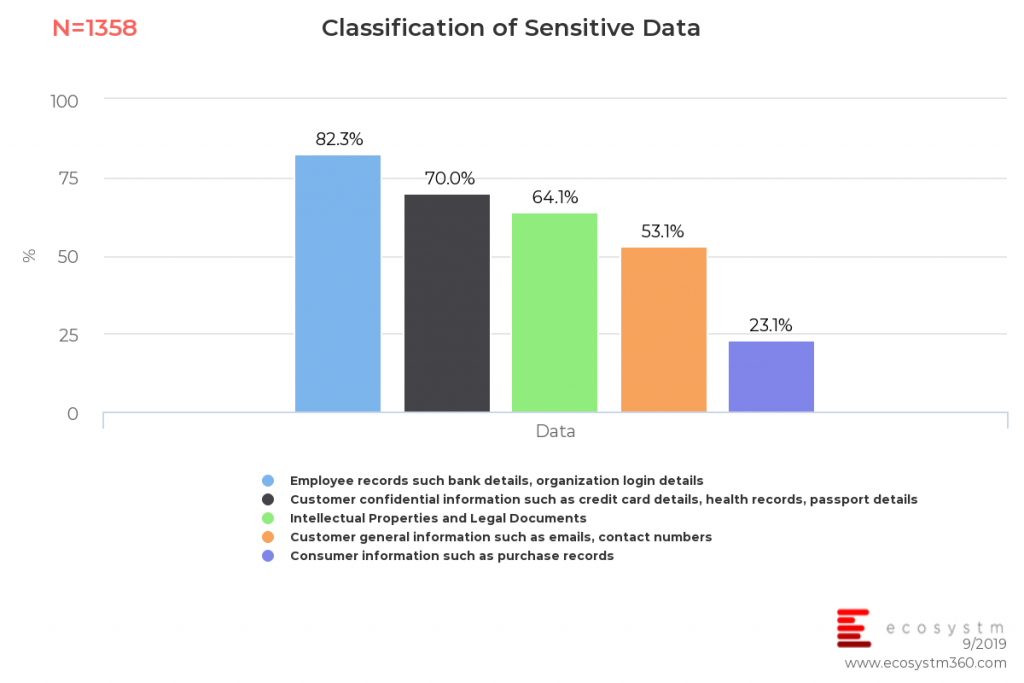
There is a greater emphasis on compliance and whilst many contact centres will claim that they have the processes in place, some of these have not been looked at for years. Compliance impacts the IT Manager, the agents, the Supervisor and ultimately the business. An automated compliance solution will help detect violations, prevent errors and allow for better visibility across different systems. She presented how Macy’s claims to have reduced their infrastructure and storage costs by 40%, through automating and deleting interactions that were no longer required. This helped lower IT costs and reduced time on audits. With the emphasis today on data privacy, data storage, data deletion and being compliant when you talk to your customers, the CX agents have a critical role to play in ensuring compliance.
Ecosystm comment:
Organisations across the Asia Pacific region are re-inventing how they look at CX as mentioned in my previous blogs. Banks, airlines, retailers, telcos and organisations from other verticals are investing in projects to drive transformation in CX. Applying deep analytics along every step of a customer’s journey will help the contact centre and the wider organisation better serve customers. The traditional methods of just looking at inbound and outbound interactions and setting KPIs for that, are no longer enough to drive this new vision. Machine learning, customer journey mapping and analytics, as well as shifting to the cloud is needed to drive transformation and agile ways of running CX. The Brand Embassy acquisition is an important one for NICE given one of the challenges not addressed by contact centres is integrating the various social and messaging applications and making them available to customers as a way to interact with the brand. This is an area contact centres have been looking to resolve.
In a highly competitive CX market where CRM, analytics, cloud and machine learning technologies are important aspects of a CX journey, NICE is investing in these areas to further strengthen their cloud contact centre value proposition. Compliance as highlighted earlier cannot be ignored and it is an area contact centres will be looking to invest in due to the multiple strict regulations underway across the Asia Pacific region surrounding how customers data is treated.







